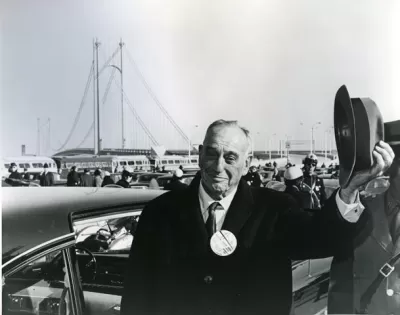Planopedia
Clear, accessible definitions for common urban planning terms.
Who Is Robert Moses?
Known to some as the 'master builder' and to others as a villain in the history of New York City's development, Robert Moses was an influential and controversial city official who guided the construction of hundreds of projects in the mid-20th century.

Born in 1888, Moses grew up in New Haven, Connecticut and New York City. After attending Yale University, he went on to study political science at Columbia and then work for the Municipal Research Bureau. He eventually became chief of New York's state park system and New York City Planning Commissioner, among dozens of other roles. Moses unified New York State's park system under a Council of Parks, which before his tenure was administered by a variety of agencies. As New York City Parks Commissioner in the 1930s, Moses built hundreds of playgrounds, three zoos, a series of massive outdoor pools, and other amenities.
He first served in public office as New York Secretary of State from 1927 to 1929, during which time he consolidated 187 agencies into 18 departments, laying the groundwork for his future involvement in public works. Holding as many as 12 public offices at the same time, Moses became a hugely influential force on New York City's planning and design. He founded dozens of self-sustaining public authorities that are still largely responsible for the city's infrastructure projects.
When President Franklin D. Roosevelt's New Deal made available millions of dollars for infrastructure projects, Moses had several shovel-ready plans ready to go, such as a network of 11 public pools and bathing facilities in the city's parks. In New York City alone, he built 658 playgrounds, 416 miles of parkways, and thirteen bridges, such as Long Island's Meadowbrook State Parkway, the first fully divided limited access highway in the world. As chairman of the Triborough Bridge Authority, Moses built the Triborough toll bridge connecting Manhattan, the Bronx, and Queens. One of Moses' major projects, the Belt Parkway, required infilling much of the Jamaica Bay–a move now blamed for causing more extensive flooding and damage during storms like Hurricane Sandy.
After Mayor Fiorello LaGuardia's retirement, Moses gained even more control over infrastructure and public housing projects. He also stopped the implementation of a citywide Comprehensive Zoning Plan, which would have reduced his power.
Critics argue many Moses projects were built at the expense of the poor neighborhoods that were razed to make way for highways and parks without input from the community. His massive infrastructure projects that favored large-scale redevelopment and 'slum clearance' tactics put him at odds with urbanists and community activists like Jane Jacobs, who argued against the wholesale destruction of neighborhoods for the sake of civic projects like expressways and parks. Moses famously clashed with Jacobs over his plans to build an expressway through the middle of Washington Square Park, a plan passionately opposed by Greenwich Village and Soho residents.
His philosophy is apparent in a quote attributed to Moses by Robert Caro: "You can draw any kind of picture you want on a clean slate and indulge your every whim in the wilderness in laying out a New Delhi, Canberra, or Brasilia, but when you operate in an overbuilt metropolis, you have to hack your way with a meat ax." In other words, Moses viewed displacement as the necessary breaking of a few eggs for the proverbial omelet. As chairman of the city's Slum Clearing Commission, Moses was responsible for the demolition of neighborhoods considered "blighted," despite residents' protests.
Moses and his projects began falling out of favor in the 1950s, when a series of missteps—such as his vehement opposition to a free Shakespeare in the Park program—and a growing awareness of the problems with widespread 'slum clearance' brought about increased public criticism. The 1974 publication of Robert Caro's sharply critical The Power Broker dealt another blow to the master builder's reputation. Moses died in 1981 at the age of 92, leaving behind a mixed legacy that, for better or worse, continues to influence city planning today.




























